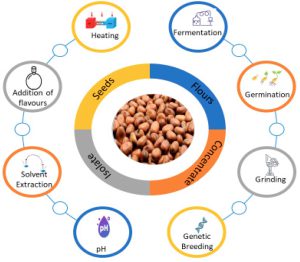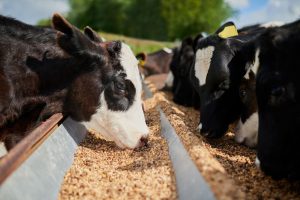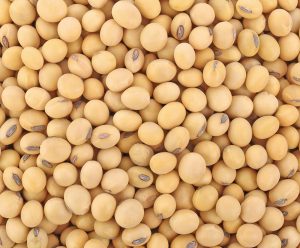Roasted, full-fat soybeans are not superior to extruded beans. In fact, adhering to the guidelines for roasting vs. extrusion is much more difficult with roasting. It is essential to exercise rigid control over the heating and the diet formulation; Maintaining proper temperature, speed through the roaster, etc. makes proper roasting of soybeans a real art. However, it can be done and many people do so. Really, it is a matter of economics more than feed quality.
Roasted soybeans are also used in dairy rations. I am sure there is a significant cost difference between the two methods.
EXTRUDED SOYBEANS
The economic feasibility of feeding extruded soybeans to swine is affected by the differences in nutrient content compared to soybean meal, the need to increase the protein in diets containing whole soybeans, the value of extra fat and the cost of processing. In order to determine if using extruded soybeans is economically feasible, the following equation can be used:
A = .86 Y + .18 Z -(S+C), where
A = Cost advantage of extruding soybeans
Y = Cost of a ton of soybean meal (44%)
Z = Value of a ton of supplemental fat
S = Value of a ton of soybeans
C = Cost of extruding a ton of soybeans
.86 comes from 38 w 44 (38% protein in soybeans and 44% protein in soybean meal); .18 is for 18% extractable fat from soybeans. The cost advantage of extruded beans depends on the realtive value of soybean meal and soybeans (holding supplemental fat constant at 15″ per pound and extrusion cost at $40 per ton of soybeans).
It requires 35 bushels of whole full-fat soybeans to make a ton of extruded beans due to the loss of >moisture (5%) during the extrusion process.
ROASTED SOYBEANS
“Properly” roasted soybeans can be used in growing-finishing swine diets. But to effectively use roasted (heated) soybeans as a replacement for soybean meal, it is essential to exercise rigid control over the heating and the diet formulation. In using roasted soybeans I would recommend the following:
1. The temperature of the roasted beans should be within 220 to 245 degrees F at the discharge point.
2. When roasted, full-fat soybeans serve as a complete replacement for soybean meal as a source of supplemental amino acids, the dietary protein level should be increased 1 to 1 1/2% to maintain the same dietary calorie:amino acid ratio.
I am not familiar with all of the portable roasters that are advertised, but the key is the ability of the roaster to reach the “proper” temperature and the length of time the bean travels through the roaster.
Roasted soybeans can be used in swine rations. Research has evaluated the nutritional value (metabolizable energy ME, etc) of roasted soybean. In general,soybeans that are properly roasted, that is processed with sufficient heat to inactivate anti-nutritional factors but not destroy the protein, make good source of protein for swine.
The use of roasted soybeans versus Soybean Meal is as much an economic decision as a nutritional decision. Several research studies comparing roasted soybeans to soybean meal have indicated that properly roasted soybeans are nutritionally equal or possibly superior to soybean meal for swine. The key, of course, is “properly” roasted soybeans. When soybeans are roasted, as opposed to extruded, they must be roasted at the correct temperature and the correct length of roasting time. Proper roasted soybeans should not have enough residual trypsin to result in decreased protein utilization. But, again, I emphasize the importance of “proper” roasting procedures.
Please allow me to give you the results of a Nebraska study comparing roasted soybeans to soybean meal.
272 cross bred pigs in three studies were fed diets differing in the manner in which ground roasted soybeans replaced soybean meal in 14% and 16% crude protein corn-soybean meal diets for pigs from 50 to 230 pounds live weight. In general, the treatments used in these studies did not affect average daily gain. A slight improvement in feed conversion was observed when roasted soybeans were substituted for soybean meal in the diet. The researchers concluded that,overall, the replacement of soybean meal with roasted soybeans provided neither beneficial or adverse animal performance. If you can formulate nutritionally adequate diets for growing-finishing pigs and lactating sows using properly roasted soybeans for a lower feed cost, I would encourage you to do so.
In Vitro Accessibility of Untreated, Toasted, and Extruded Soybean Meals for Proteases and Carbohydrases
The in vitro accessibility of the water unextractable solids (WUS) from untreated, toasted, and extruded soybean meals toward different enzyme activities was studied. WUS was incubated with seven commercial enzyme preparations. Two enzyme preparations were selected for further research. Upon addition of Neutrase, the extruded sample yielded considerably more solubilized protein compared with the toasted and untreated soybean meals. Energex solubilized high amounts of neutral sugars after heat treatments compared with the untreated meal. Cell wall polysaccharides solubilized by the enzymes were released as small oligosaccharides and monosaccharides. SDS−PAGE analysis showed that after enzyme addition to the extruded sample, proteins were more rapidly and completely degraded compared with enzyme addition to the toasted and untreated soybean meals. Neutrase degraded both β-conglycinin and glycinin. Energex could only, partly, degrade β-conglycinin. The basic polypeptide from glycinin showed the highest resistance against proteolytic activity.
Keywords: Soybean meal; toasting; extrusion; enzymes; protein; cell wall components
FEEDING WHOLE SOYBEANS TO FEEDLOT CATTLE
Stephen Boyles
OSU Extension Beef Specialist
Growing Diets: Davenport et al. (1988) observed in several trials that soybeans were an acceptable protein supplement for growing cattle. However, the calves consuming corn silage and supplemented with soybeans did not perform as well as calves supplemented with soybean meal. Soybeans are highly degradable in the rumen which results in a possible deficiency of protein reaching the small intestine. Growing cattle diets supplemented with soybeans may benefit from blending in a “high-bypass” protein source. However, an Oregon study did not detect calf body weight gain difference in supplementing a hay-based diet (6.5% crude protein) with 3 pounds of whole raw soybeans or 2 pounds of soybean meal plus 1 pound of barley. Roasting soybeans can increase their “by-pass” potential (Cosby et al., 1995).
Finishing Diets: The University of Missouri recently completed a 58-day feeding trial using whole soybeans to replace all or part of the soybean meal (Felton et al. 1998). Eighty steers were allotted to one of four dietary treatments. The following were the four diets tested.
Table 1. Composition of whole soybean diets (Percent of Dry Matter)
| Diet | WS-0 | WS-8 | WS-16 | WS-24 |
| Corn | 72.57 | 70.27 | 68.00 | 65.87 |
| Corn Silage | 8.00 | 8.00 | 8.00 | 8.00 |
| Soybean Meal | 17.30 | 11.60 | 5.80 | 0.00 |
| Whole Soybeans | 0.00 | 8.00 | 16.00 | 24.00 |
| Limestone | 1.50 | 1.50 | 1.50 | 1.50 |
| Salt | 0.50 | 0.50 | 0.50 | 0.50 |
| Vitamin/Mineral | 0.10 | 0.10 | 0.10 | 0.10 |
| RumensinTM | 0.02 | 0.02 | 0.02 | 0.02 |
| TylanTM | 0.01 | 0.01 | 0.01 | 0.01 |
| Average Daily Gain, lbs/day | 3.4 | 3.5 | 3.2 | 3.2 |
| Feed to Gain | 6.0 | 5.7 | 5.7 | 6.0 |
| Cost of Gaina, cent/lb | 37 | 37 | 38 | 41 |
aSoybean meal = $185.70/ton; Whole Raw Soybeans = $6.25/ton; Corn = $2.82
Average daily gain and feed efficiency were unaffected by treatment. Initial body weight, final body weight, and carcass weight were similar for all steers across dietary treatment. Ribeye area, kidney-pelvic-heart fat, backfat, dressing percent and yield grade were also similar.
The two higher levels of whole raw soybeans (WS-16 and WS-24) were not economically beneficial. However, Felton et al. (1998) concluded that whenever the cost of whole raw soybeans are at or below 94% of the cost of soybean meal, higher dietary inclusion rates of whole raw soybeans would be economically beneficial. Keep in mind though that moisture level in beans will affect their economic value and beans with mold should not be used.
Iowa researchers (Trenke et al. 1995) observed that steers supplemented with soybean meal or soybeans (ground or extruded) gained more weight and were more efficient during the first 70 days on feed compared to steers supplemented with urea. However from 70 days to 204 days on feed, the urea supplemented steers gained more weight and were more efficient. Economic returns were similar for soybeans, urea, and soybean meal. Therefore soybeans must also be price competitive with supplements containing urea to be economically feasible.
I have not come across any trials feeding blends of urea and raw soybeans to cattle and perhaps for good reason. Raw soybeans and urea are both highly degradable in the rumen so there may be no particular nutritional advantage. Soybeans would probably need to be ground to maintain a mixture of urea with soybeans. Raw soybeans contain the enzyme urease, which breaks down urea to ammonia. Cattle don’t like the taste or smell of ammonia and cattle would probably would find the mix less palatable. Heating soybeans is required to destroy the urease enzyme if they are to be used as a protein source for pigs.
Carcass Composition: Felton et al (1998) did not observe significant differences in marbling between steers fed whole raw soybeans or soybean meal. However, they noted a numerical trend towards increasing the quality grade with increasing levels of whole raw soybeans. Cosby et al. (1995) observed a slight numerical decrease in quality grade when feeding roasted whole soybeans. Trenkle et al. (1995) noted that feeding soybeans increased the amount of polyunsaturated fat. Unsaturated fats are preferred to saturated fat in human diets. A targeted marketing alliance may be able to merchandise possible carcass composition differences.
Literature Cited
Bunting, L. D., J. M. Fernandez, R. J. Fornea, T. W. white, M. A. Froetschel, J. D. Stone, and K. Ingawa. 1996. Seasonal effects of supplemental fat or indegradable protein on the growth and metabolism of Holstein calves. Journal of Dairy Science 79:1611.
Cosby, N. T., T. L. Stanton, and D. Koester. 1995. Effect of level of roasted soybeans in whole shelled corn diets on finishing steer performance and carcass characteristics. Colorado State University Beef Program Report. p. 29.
Felton, E. E. D., A. J. Cox, and M. S. Kerley. 1998. Value of whole soybeans for feedlot cattle. University of Missouri-Columbia Animal Sciences Departmental Report. p. 21.
Trenkle, A., H. Shu, E. Lonergan, and F. C. Parrish, Jr. 1995. Effects of feeding soybeans on performance and fatty acid composition of muscle tissue of steers fed corn-based diets. Iowa State University Beef Research Report. AS-630. p.108.
Davenport, G. M., J. A. Boling, and N. Gay. 1988. Ground soybeans, fishmeal, and rumen-protected lysine for growing calves fed corn silage. University of Kentucky Beef Cattle Research Report. Progress Report 306. p. 67.


